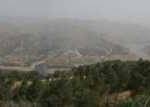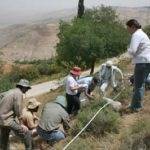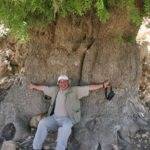A team from the National Botanic Gardens has recently returned from an 11 day trip to the Royal Botanic Gardens of Jordan. The purpose of the visit was to give assistance with planning at the gardens, and developing a long-term research strategy for vegetation monitoring, recovery and re-creation at the site.
The Royal Botanic Garden is sited at Tel al-Rumman, 20 km North of the capital Amman, on approximately 800 hectares of steep slope overlooking the King Talal Dam (see above). The site of the gardens has already produced a checklist of nearly 500 plant species.
recording quadrats at the Royal Botanic Gardens with RBG, NCARE and NBG staff Like much of Jordan`s Mediterranean highlands, Tel al-Rumman was once forested with deciduous oaks. Today only remnants of this vegetation remain, and intensive grazing and agriculture have left the slopes heavily denuded. The long-term plan for the Gardens includes the re-creation of five characteristic Jordanian habitats on site. The remainder of the site has been set aside for a visionary experiment into grazing management, which will form the core research activities at the gardens in the future.
The role of the Royal Botanic Gardens as a research and demonstration centre in sustainable grazing and water-use practices will be a unique and valuable role for both Jordan and the region as a whole.
During their visit, the National Botanic Gardens team initiated quadrat recording of the vegetation associations at the Gardens (above).
RBG Head Forester Kamal Nueimat has previously conducted a Survey of the Historical trees of Jordan, which was published in 2002 by the Jordan River Foundation. Kamal has tracked down numerous historic Oaks, Olives, Cypresses, Pistachios and other species throughout Jordan (right).
The National Botanic Gardens is hoping to develop a collaborative project to investigate the genetic diversity of these ancient trees and their relationships to younger populations throughout Jordan.
- Panoramic view of the Royal Botanic Gardens from west to east from the roof of the administration building.
- RBG head forester Kamal Nueimat in front of a 900 year old Pistacia atlantica at Ash Shawback near Wadi Musa.




